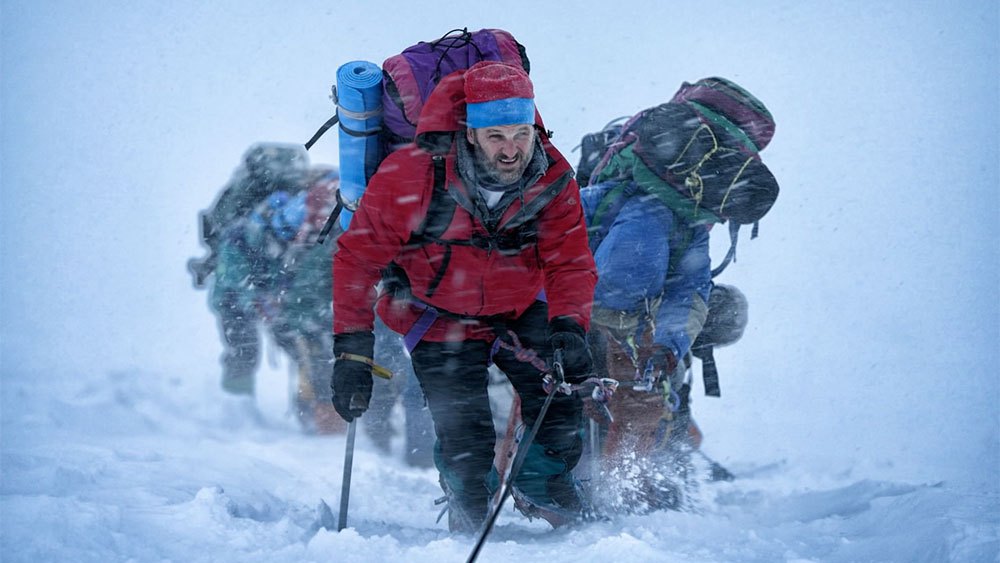| Worth seeing: | on the biggest screen that you can, since it's a visually arresting but dramatically flat retelling of the 1996 Everest tragedy |

| Director: | Baltasar Kormákur |
| Featuring: | Jake Gyllenhaal, Jason Clarke, John Hawkes, Josh Brolin, Martin Henderson, Michael Kelly, Ang Phula Sherpa, Elizabeth Debicki, Emily Watson, Ingvar Eggert Sigurðsson, Justin Salinger, Keira Knightley, Naoko Mori, Robin Wright, Sam Worthington, Tom Goodman-Hill |
| Length: | 121 minutes |
| Certificate: | 12A |
| Country: | Iceland, UK, US |
| Released: | 18th September 2015 |
WHAT’S IT ABOUT?
The highest peak on the planet, the summit of Mount Everest, used to be the preserve of a handful of professional climbers, but in the 1990s, a number of professionals turned guide and started taking tourists up to the summit. Although up until that point, a quarter of climbers who’d attempted the summit had perished during their adventure, these guides had a much better safety record. One of the most expensive trips was under the guidance of Kiwi Rob Hall (Jason Clarke), who boasted that you didn’t pay him to get you to the summit, but back down again.
In 1996, he was leading a group to the summit including seasoned climber Beck Weathers (Josh Brolin), mountaineering journalist Jon Krakauer (Michael Kelly) and postman Doug Hansen (John Hawkes), who had to quit his previous attempt and has scraped together every last penny to make one final attempt at achieving his dream.
On the day they’re due to attempt the summit, they have a shorter weather window than they’d hoped for, so Rob persuades another guide, Scott Fischer (Jake Gyllenhaal) to combine their two groups so that they’ll all be able to scale the south face within the reduced time available. But as they arrival at a crucial part of the climb, ropes that are meant to have been laid in advance aren’t there, delaying the climb by an hour.
With even more of a time pressure on the larger group, cold and fatigue start to take their toll as one by one they reach the summit and finally begin the descent.
But on the way back down to base camp, a severe storm hits the group and a delay too many means that some of the climbers become trapped in what’s not known as the Death Zone for nothing.
WHAT’S IT LIKE?
The first point to make is that this film is based on real-life events, which means you have to be prepared for the story not to conform to your typical Hollywood disaster movie. Anyone who knows anything about what happened on that fateful day in 1996 will know that Everest will not have typical Hollywood ending. And anyone who doesn’t will be brought up to speed by a caption, informing viewers that a quarter of those attempting to “summit” Everest die, which means that no-one can truly be surprised that about a quarter of the characters in the film do indeed fail to make it back.
That being the case, for anyone who knows the story well, this will lack drama and for anyone who doesn’t, it’s likely to be a thoroughly draining and downbeat experience, as real-life starts to veer away from the standard film industry standard screenplay structure.
There is certainly a sense in which producing a fictitious film about a group of fictitious characters getting caught in a storm near the summit of Everest could have made for a similarly exciting but more emotionally satisfying experience, while tying themselves to reality limits the film-makers’ creative possibilities and inevitably sends the audience into a frustrating emotional cul-de-sac; those who know only the vague details of what happened can at least enjoy the standard cinematic journey of trying to work out who to bother rooting for, although even then, it largely seems signposted well in advance.
There’s only one character whose journey is truly surprising, but as one of the second-tier characters, on a cinematic level, it’s certainly unconventional.
With so many climbers on the mountain that day, many of them are glossed over and serve as little more than wallpaper, which adds to the frustration of trying to follow the individual stories of those taking part in the expedition – not least because for most of the time, they’re wearing so many clothes and the weather is so severe that it’s hard to tell who we’re watching.
And often, the characters we follow the most closely aren’t necessarily the most heroic, or indeed those with the most interesting back-stories; Anatoli Boukreev (Ingvar Eggert Sigurðsson), a Russian guide on Scott Fischer’s team feels like a typical Hollywood hero, using unorthodox means to save more lives than anyone else, but he gets relatively little screen-time and even less thanks for his efforts.
The reason for this, it turns out, is that for everyone involved there is a different perception of the events of that day and one of the main records of the tragedy, from the journalist who was there, Jon Krakauer, is highly critical of the actions of Boukreev, who in turn went on to publish his own account of what happened, attacking Krakauer’s conclusions. Rival recollections makes you question the validity of what you’re watching, adding to the suggestion that a fiction might have been a more reliable venture.
Being from Iceland, the director Baltasar Kormákur is no stranger to snow, but – with the aid of the 3D technology, a comfortable budget and spectacular Himalayan and Alpine scenery – he delivers a particularly visually arresting and at times heart-stopping thriller, which bristles with an air of authenticity.
The casting is interesting in some senses, because two of the biggest names – Keira Knightley and Robin Wright – are somewhat wasted, playing wives who spend the whole film on the end of a phone back home, while two other strong female performances see Emily Watson and Elizabeth Debicki as women back at base camp, doing little more exciting than looking at weather maps and shouting into radios. Not all the women are sitting in the warm though – there is one among the climbers, but either her story isn’t engaging enough to dwell on or western audiences presumably wouldn’t be so interested in her, as she was Japanese.
Then there’s another of the high-profile names, Sam Worthington, as a fellow mountaineer, who starts the film on a neighbouring peak and when he sees danger looming, heroically rushes down to base camp to help in the rescue efforts – by making a few phone-calls.
Given that there are so many viewpoints to choose from, it’s a shame that there’s little analysis of what actually went wrong. Was the tragedy down to the failure to prepare the ropes for the climb and if so, whose fault was that? Was it simply bad luck that a storm came in when it did? Was Scott Fischer not in good enough shape to have been leading his group? Did Rob Hall himself bear any responsibility for being too soft when he needed to be hard, if indeed that is even how it happened?
Prioritising the often mind-blowing mountain sequences, Kormákur provides only one scene where the characters try to explain why on earth they’d want to put their lives at risk, conveniently in the form of interviews for Krakauer’s original article, although unlike this week’s other life-changing expedition release, A Walk In The Woods, this film does little to sell its hobby of mountaineering.
So Everest is a visually stunning, epic nail-biter of a thriller with an unconventional Hollywood structure, insufficient emotional impact and ironically, for a film about the world’s highest peak, dramatically flat. And with so much controversy over many of the specifics of what happened, there’s a question over how accurate the narrative really is anyway. As such, if you’re going to see it, make sure you find the biggest screen you can to enjoy it as an experience, rather than a piece of cinema.
